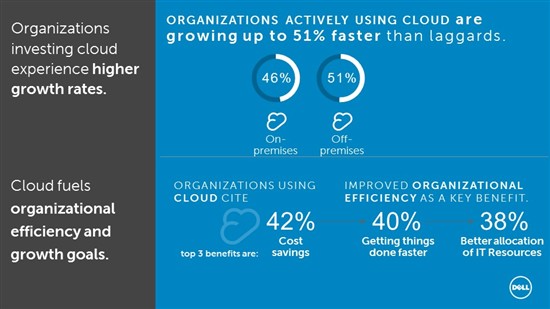According to the 2015 revision of Dell’s Global Technology Adoption Index (GTAI), companies investing in cloud are growing up to 51 percent faster than organizations not investing in cloud technology. It’s hard to tell if these companies are growing solely because of the advantages of cloud, or if their workplace culture is quick to adapt to change, allowing them to embrace growth opportunities and evolving technologies.
Driving business growth is a top priority for C-suite executives, and in the digital age, business growth is increasingly fueled by new technology. This means Chief Information Officers (CIOs) are getting more involved in the corporate strategy to drive organizational change and thought leadership. It’s no wonder the Economist Intelligence Unit found: “CEOs who involve their CIOs in setting business strategy outperform their peers by a margin of almost 2:1.”
We believe these added responsibilities provide the CIO an unprecedented opportunity to make a real difference. Forward-thinking CIOs will embrace the future, rethink IT in the context of overall business strategy, and adopt new approaches (such as cloud) to expedite customer acquisitions, expand to new territories and differentiate through innovation.
Our experience working with global technology leaders across industries reveals that they are, in fact, realizing the benefits of cloud deployments. These include simplified internal operations, improved use of internal resources and new, innovative ways for employees to work, connect and collaborate.
However, one of the less-discussed benefits of cloud is the substantially quicker time-to-market and time-to-value compared to traditional infrastructure methods. And we’re not just talking about creating virtual servers in minutes. Lead times are slashed, especially for applications launched on the same platform used for development. CIOs no longer need to invest time and resources to maintain and manage complex technologies or infrastructures as these are taken care of by the service provider. This allows the CIO to focus their critical resources on higher-value tasks that support the core mission of the business.
For example, we helped a banking and finance organization in the U.S. reduce customer onboarding time from six month to mere weeks with cloud services. This means faster revenue realization, improved customer experience and readily available critical resources for strategic initiatives. For organizations looking for similar results, we suggest they consider the following:
- Look at cloud as a tool, not a strategy: Cloud technology is not a strategy. While it’s true the cloud has immense potential to provide solutions to many business challenges, it can’t and shouldn’t be the ultimate IT strategy. Cloud should be viewed as a tool used in a broader IT strategy that solves business challenges and achieves objectives.
- Evaluate solutions that align with strategic outcomes: It’s important to rethink the way IT environments are managed. Our strategy at Dell Cloud Services allows IT departments to focus on the workloads themselves, enabling IT to become a service-centric provider that supports their internal customers. This is a very important shift when compared to traditional IT strategies; it empowers IT departments to primarily focus on growth and business outcomes.
- Invest in solutions that avoid lock-ins: Flexibility is important in the cloud world. In a rapidly evolving market, a multi-cloud reality is unescapable. Find solutions that provide the flexibility to move between cloud technologies. Business and IT organizations are very dynamic, and organizations need the ability to work with diverse applications and systems from numerous cloud vendors. Make sure to avoid vendor lock-in to allow for this cross-cloud consumption.
- Be prepared to drive transformation: Different companies require different approaches to cloud adoption. At Dell, we know a one-size-fits-all cloud service is not the most effective way to modernize IT systems. A well-defined and customized plan that includes organizational change management is needed for true transformation — not only for technology specifications but also to implement a rollout that won’t interrupt operations.
A few years ago, Kodak — then an industry leader — had an opportunity to adopt new digital platforms; but the organization failed to adapt. The rest, we know, is history. CIOs today are in a similar situation, as businesses are expected to adopt solutions such as cloud to be future-ready. The advantages of cloud computing are impressive, but they require a paradigm shift in IT management and strategy. We believe a cloud infrastructure model will be imperative to supporting an agile business that delivers true value.
The choices that CIOs make today will decide their fate tomorrow.
